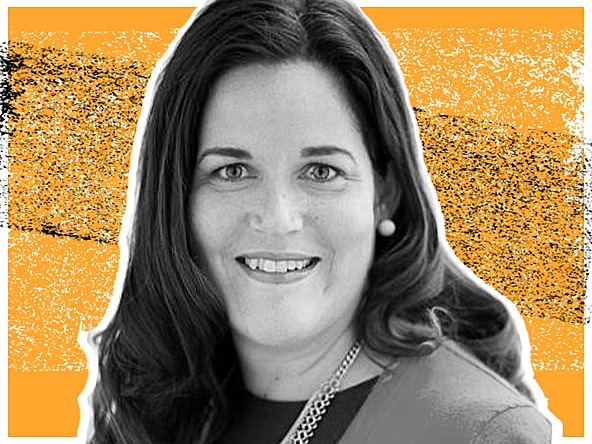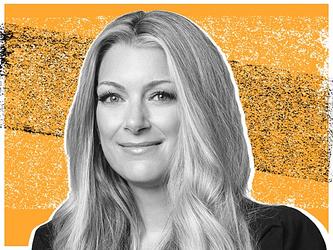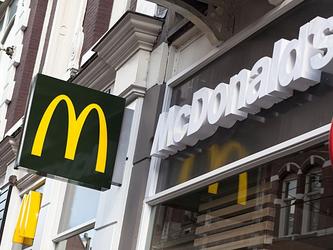How I work: Michelle Gansle, VP, global insights & analytics, McDonald’s

Katie McQuater (KM): What does an average day look like for you?
Michelle Gansle (MG): I don’t know if there is an average day but more often than not, being in a global role, I tend to get to work early. Often, my meetings start around 7am and I get to work around 6/6.30am. And then it’s pretty much in meetings all day until about 4pm. I usually clock off between 4-6pm so that I can have some downtime but also so that I don’t end up working 12 hours every day. I use that time often just to recharge.
I’m based in Chicago and I also travel a lot in this role, which I enjoy. I could be in control of how much I travel but I think it’s important that I spend time in the countries where we operate and in the restaurants where we actually sell burgers and fries. So, I probably travel internationally once every three to four weeks.
KM: What keeps you sane during those trips? Do you have any tips to make the process a bit easier?
MG: I keep saying I’m going to write a booklet on how to avoid jetlag. It’s just a really simple thing that most people don’t do, which is that once you get on a plane, you have to immediately stay on the local time of where you’re going. For example, when I fly from Chicago to the UK, even if it’s a 4pm flight, you’ve got to get on that flight and go to sleep, because otherwise you’re screwed for a week. Then on the way back, stay up, don’t sleep on that plane. Not suffering from jet lag the entire time you’re on a trip helps significantly.
I also try to do things to help maximise the trip while I’m there, like working out when you arrive. I like plane time, because I’m not in meetings, so I can read a book or listen to a podcast or catch up on emails.
KM: Are you working from home at all?
MG: We have a hybrid work environment, our goal is about three days a week in the office. Some weeks it’s more and some weeks it’s less, but on average I’m here three days a week. McDonald’s is a very relationship-based company so they really value people interacting and connecting – that drives a bit of the desire for a hybrid culture.
KM: Does the type of work you do vary depending whether you’re in the office or is it the same regardless of location?
MG: Regardless of location, the day looks pretty similar. The difference is, when I’m in the office, I really make an effort if I have a little spare time, to walk around and connect with people I wouldn’t necessarily, because that’s the whole point of it. When you’re at home you’re only really talking to people you have to talk to.
KM: How do you maintain communications around the globe with your teams?
MG: We have a series of formal and informal ways. Formally, we’ve got various meetings and forums to connect and in the top five or six markets I do one-on-ones once a quarter with the insights leads in those markets, or sometimes we have a CMO forum with the CMOs in those markets. If I have spare time, I’ll pick up the phone or send someone an email if I’m thinking about them, to maintain that relationship.
KM: How do you have good boundaries? What helps you to make the distinction between work and life?
MG: It’s funny that you start with that. What if I didn’t have good boundaries?
KM: I’m assuming you do!
MG: I do have good boundaries, I thank Mars for that. I worked at Mars for 15 years and they’re very passionate about work-life balance. It’s like when you’re in an air plane and they tell you to put on your own mask first before helping someone else, it’s kind of that same idea. If you’re not in a good place physically, mentally and emotionally, how can you help others?
I’ve really taken that into McDonald’s with little things like taking all four weeks of my vacation every year, and I tell people that if they really need me they can reach out to me but I make an effort not to check emails, or if I check them I’m not going to respond.
Once in a while I’ll write emails on Sundays. We’ve had huge debates about that; should you delay your emails and not send them on weekends? But some people just work better on weekends. If you want to stop at three every day but then catch up, we shouldn’t stop people from doing that, so culturally is it the right thing to say don’t send emails on Sundays because you stress people out? Or should you just let people do what they do and accept that if you’re someone who doesn’t want to work on Sundays, don’t look at your emails on Sundays and there’s no expectation to reply? But I try to limit working on weekends – I try to keep my work to Monday to Friday.
KM: So, it’s about being responsive to how colleagues see flexibility.
MG: Yes, and Covid has really changed that. Work-life balance used to be working a nine to five, and if you’re working evenings or weekends, you’re not healthy. Now, work-life balance is finding a way to integrate personal and work life in a way that works for you and don’t overwork. Take vacations and take time off to go and pick your kid up.
I like that we’ve evolved to that but it requires more communication, so one thing I like to do when I’m working with someone new – either a new boss or a new direct report – is I have this ‘ways of working’ page. It asks: ‘What motivates you? What annoys you? What’s your style of working? How do you like to communicate?’ So, you can talk about that, and then you’re contracting with each other how you’re going to be with each other.
KM: What’s your style of working? How do you prefer to engage with people and get your work done?
MG: I’m very informal. Some people have work personas and personal; I am who I am in and outside of work, it’s part of my charm. I definitely prefer conversation, especially if it’s complicated. I always tell people that I get 300-plus emails a day – there’s no way I’m ever keeping up with emails. So, if someone sends me something important that they need me to read and react to, they need to send me a text so I can make sure to pay attention to it. I would much prefer a text, a phone call or a drive by my desk than death by a thousand emails.
During a recent break I got my inbox down to zero and it felt so good! I didn’t realise how much stress that was subconsciously causing me until I got it to zero.
KM: Are there any tips or tricks you’ve learned about productivity or managing your work?
MG: In Myers-Briggs, I’m an ENFP so that means my work flows with my energy. I’m not super process-oriented. I’m organised when I have to be, but if I don’t have to be, it can spiral.
Luckily, I have the most amazing admin on planet earth and she helps a lot. I had a mentor once ask: ‘do you track your meetings and how you spend your day to make sure it’s balanced between internal and external or between managing up and managing down?’. One thing my admin has implemented for me that has made a big difference, is colour-coding my emails into these different categories – internal, external, bosses, direct reports, peers – to help me roughly calculate how I’m spending my day and my week to make sure that it’s balanced and I’m not overly tilting one way or the other. That’s really been a surprising help to make sure I’m doing what I’m supposed to be doing.
I also block in work time, I schedule in for exercising and if I need to read or focus on a presentation, because otherwise it’s so easy just to get sucked in to reactively going to all the meetings that I get invited to.
KM: What priorities are currently keeping you busy at work?
MG: We are working on a restructure to help us be less siloed and work more collaboratively between the global markets and that’s taking up a lot of work on top of the day job; thinking about the future and how we manage work flow. It’s exciting and I love working on that kind of big picture future stuff but it’s definitely taking up time.
Also, I lead the insights and the analytics/data science teams, so a lot of the work we’re doing now is how do we maximise the value from the data that we have – and not only understanding the ‘what’ but the ‘why’ and the ‘so what’ and ‘what’s next’. We have created a team consisting of foresights, insights, analytics, data and data science, and what is exciting about connecting them is that rather than them be in pockets, working in isolation, they’re working collaboratively together, which theoretically should provide more valuable insight.
KM: Thinking about the industry more generally, has there been a change in dynamic in the role insight plays in organisations?
MG: Yes, I used to say during the Covid times, that sadly it was the best thing that could have happened to the insights industry, because we became more important and relevant again. What was happening is that we were competing with data science and advanced analytics, and more and more CMOs and leadership teams were going more towards that and understanding the ‘what’ and getting excited about shiny things like AI, and I feel like insights teams were struggling to stay relevant and continue to have the infamous seat at the table.
When Covid happened, people realised you can’t look to the past to predict the future, so now we need help understanding what’s going on and what will happen. Foresight has become a big thing – you see foresight teams popping up around the world, which didn’t really exist previously, except in pockets, and what’s happening more now is insights and analytics teams are starting to come under one team.
Maybe I’ve just been lucky in my experience, but insights [teams] across the whole business, not just marketing, are starting to see the relevance of what we can deliver, both from a data perspective and an insights perspective, and I feel like we’re starting to infuse ourselves everywhere in the business – not just in marketing.
KM: What motivates and drives you outside of work?
MG: I live with my partner Tom and our three beautiful cats. I had two, he had one and now we live together and have three. We chose not to have kids – I enjoy a lot of freedom that maybe not a lot of couples have. I often spend that freedom travelling, personally as well as professionally, and collecting experiences, often food related.
KM: Are there any final tips you would like to share?
MG: One thing I learned from Brené Brown’s book is the two-word check in, where you go around the room and ask people to give two words about how they’re feeling today, like ‘happy and motivated’ or ‘frustrated and anxious’. It just helps you to understand the vibe of the meeting or room, and if there are any issues to be addressed.
It’s a small but simple thing that makes a big difference – especially right now, with people struggling with everything happening in the world – giving space to recognise that people bring their whole selves into work. Just pretending, just getting into the meeting, feels insensitive and tone deaf – so, right now, it’s super important that we give space for people to bring their personal lives into work.
This interview has been lightly edited for clarity.

We hope you enjoyed this article.
Research Live is published by MRS.
The Market Research Society (MRS) exists to promote and protect the research sector, showcasing how research delivers impact for businesses and government.
Members of MRS enjoy many benefits including tailoured policy guidance, discounts on training and conferences, and access to member-only content.
For example, there's an archive of winning case studies from over a decade of MRS Awards.
Find out more about the benefits of joining MRS here.













0 Comments